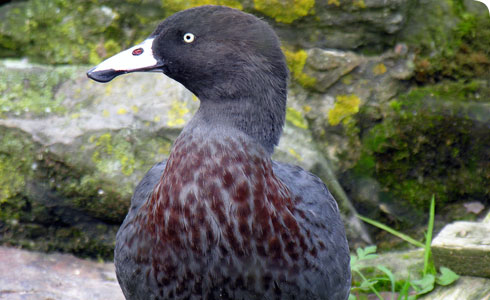Conservation
The blue duck is classified as endangered by the International Union of Conservation for Nature (IUCN) 2002 due to its gradually declining range and fragmented population density.
Recent rapid decline on South Island is almost certainly due to predation by introduced mustelids, such as stoats.
The population of blue duck is declining, and unless the causes of decline are addressed, the species faces a risk of extinction.
Conservation pioneers
The modern scientific approach to blue duck conservation was introduced by Janet Kear in the late 1960s. She was an enterprising Englishwoman who, with the help of the New Zealand hunter and wildlife officer Tom Steel, discovered and published details of the blue duck’s habits and way of life.
This raised the profile of blue duck and consequently the New Zealand Wildlife Service’s Murray Williams began the first and only systematic study of the species - this lasted over 15 years. Dr Williams' work still forms the basis of our knowledge of the ecology, habitat requirements and threats for the species.
Management
New Zealand’s Department of Conservation produced a second Blue Duck Recovery Plan in 1997. It is a 10-year plan that prioritises survey and monitoring work of blue ducks to establish numbers and trends in their populations, as well as addressing the need to protect their remaining habitat.
Blue Duck Recovery Plan - Department of Conservation, New Zealand
Threats
Blue duck populations face several major threats.
Habitat loss is a significant problem, due to:
- forest clearance for agriculture
- poor river-side management causing reduced water quality
- some rivers are being manipulated for hydro-electric power generation or irrigation which changes the characteristics of rivers making them potentially unsuitable for blue duck
Predators, including introduced mammals, play a significant role in the decline of the blue duck. Stoats probably pose the greatest threat by attacking females on the nest, stealing eggs and taking ducklings from the river’s edge. Rats and possums are also likely to take eggs. Feral cats, domestic dogs and ferrets also predate blue duck.
Human activity may also adversely affect blue duck populations, including the use of rivers for:
- white water rafting
- kayaking
- hunting
- angling
